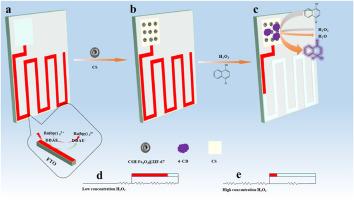A visual electrochemiluminescence sensor based on the combination of distance-readout strategy and nanozymes catalyzing precipitation
IF 5.7
2区 化学
Q1 CHEMISTRY, ANALYTICAL
引用次数: 0
Abstract
Background
Nanozyme is a kind of biomimetic enzyme with unique properties and catalytic function of nanomaterials. Various nanozymes have been applied in the development of visual biosensors because of its excellent stability and availability. Nevertheless, the current applications of nanozymes primarily focus on colorimetric sensing based on color changes, which is susceptible to external factors interference including sample solution color and ambient light. Incorporating a distance-readout strategy with nanozymes presents a promising avenue for the advancement of innovative visual biosensing technologies in the future.
Results
A visual electrochemiluminescence (ECL) sensor was developed by combining the distance-readout strategy with nanozymes catalyzing precipitation for the first time. The detection is based on the ECL length change induced by nanozymes. This sensor chip comprises a square detection area and a visual ECL channel area. A peroxidase-mimic, core-shell hollow Fe3O4@PDA@ZIF-67, was modified in the detection region. The substrate 4-chloro-1-naphthol was rapidly catalyzed by nanozymes to form purple precipitate benzo-4-chlorohexanedione, leading to an increase in impedance within the detection region. Consequently, the detection area's partial voltage rose while the visual channel's dropped, resulting in a shorter ECL length. As a proof-of-concept experiment, the visual distance-readout ECL sensor was utilized for the quantitative detection of H2O2. The alteration in ECL length exhibited a good linear relationship with H2O2 concentration (logarithm) within the range of 300 nM to 300 μM, with the limit of detection (LOD) of 87 nM.
Significance
This work developed a novel approach for the application of nanozymes in analytical chemistry. Compared with common colorimetric sensing, this method is more convenient and intuitive, which can effectively eliminate potential interference from humans and the environment during signal acquisition. Because biocatalytic precipitation can be formed through multiple sensing processes, this strategy holds great promise as a portable and cost-effective tool with diverse applications.


基于读距策略和纳米催化沉淀相结合的可视电化学发光传感器
背景纳米酶是一种具有独特性质和催化功能的纳米材料仿生酶。由于纳米酶具有极佳的稳定性和可用性,各种纳米酶已被应用于视觉生物传感器的开发。然而,目前纳米酶的应用主要集中在基于颜色变化的比色传感上,这很容易受到样品溶液颜色和环境光线等外部因素的干扰。将读取距离策略与纳米酶结合起来,为未来创新视觉生物传感技术的发展提供了一条大有可为的途径。结果 首次将读取距离策略与纳米酶催化沉淀相结合,开发出了一种视觉电化学发光(ECL)传感器。检测是基于纳米酶诱导的 ECL 长度变化。这种传感器芯片由一个正方形检测区和一个可视 ECL 通道区组成。在检测区内改性了过氧化物酶模拟物--核壳空心 Fe3O4@PDA@ZIF-67。底物 4-氯-1-萘酚在纳米酶的催化下迅速形成紫色沉淀苯并-4-氯己二酮,导致检测区域内阻抗增加。因此,检测区域的部分电压上升,而视觉通道的电压下降,导致 ECL 长度缩短。作为概念验证实验,视觉距离读出 ECL 传感器被用于定量检测 H2O2。在 300 nM 至 300 μM 范围内,ECL 长度的变化与 H2O2 浓度(对数)呈良好的线性关系,检测限(LOD)为 87 nM。与普通比色法相比,该方法更加方便直观,可有效排除信号采集过程中可能存在的人为和环境干扰。由于生物催化沉淀可通过多种传感过程形成,因此该策略有望成为一种便携式、经济高效的工具,具有广泛的应用前景。
本文章由计算机程序翻译,如有差异,请以英文原文为准。
求助全文
约1分钟内获得全文
求助全文
来源期刊

Analytica Chimica Acta
化学-分析化学
CiteScore
10.40
自引率
6.50%
发文量
1081
审稿时长
38 days
期刊介绍:
Analytica Chimica Acta has an open access mirror journal Analytica Chimica Acta: X, sharing the same aims and scope, editorial team, submission system and rigorous peer review.
Analytica Chimica Acta provides a forum for the rapid publication of original research, and critical, comprehensive reviews dealing with all aspects of fundamental and applied modern analytical chemistry. The journal welcomes the submission of research papers which report studies concerning the development of new and significant analytical methodologies. In determining the suitability of submitted articles for publication, particular scrutiny will be placed on the degree of novelty and impact of the research and the extent to which it adds to the existing body of knowledge in analytical chemistry.
 求助内容:
求助内容: 应助结果提醒方式:
应助结果提醒方式:


